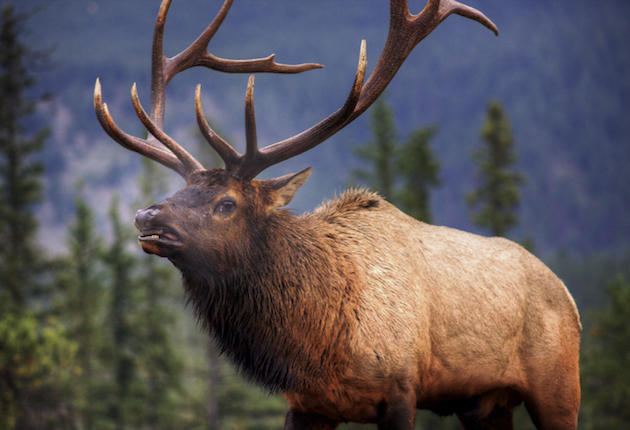Of Montana’s 138 elk management zones, 80 are listed by the state’s Fish, Wildlife & Parks department as over their objective levels. To bring populations into check as quickly as possible, Montana’s Fish & Wildlife Commission recently approved a set of shoulder season guidelines for increased harvests, providing regulations for any subsequent shoulder seasons the state may allow.
The FWC adopted the guidelines Oct. 8, amid concerns of elk overcrowding by Governor Steve Bullock, lawmakers, landowners, and others. The calls for action led FWP to research potential management strategies in the fall of 2014 and into the winter. Roughly 20 biologists were tasked with analyzing the situation and making recommendations for thinning the herds. Special permits, extended seasons, season structure changes, and other options were all considered, but ultimately the biologists selected shoulder seasons as the best technique to use.
Shoulder seasons extend on either side of the general firearm season, essentially lengthening the gun season and allowing for more elk to — at least potentially — be killed. Antlerless elk are the main focus, but bulls could be taken if an area warranted a greater level of herd thinning. If so, the taking of bulls would be regulated by permits.
Montana’s general firearm season typically runs from late October to the Sunday after Thanksgiving. Shoulder seasons, while finite in their length, could start as early as Aug. 15 and last until Feb. 15.
The season would not be a statewide season. Areas in need of thinning would be part of the additional dates, but areas already within or below management parameters would not. Hunting pressure would focus on private lands in the early season and switch to public land in the late season if needed. The goal would be to keep elk from seeking shelter on land closed to hunting — which effectively cancels out the shoulder season’s benefits.
These elements all go toward the main intent of the hunt: reduce the number of elk to objective levels as quickly as possible. Doing so will require a readiness by landowners to allow hunters access to private lands, as well as responsible actions by hunters.
“Hunting access to private land and isolated public land is clearly needed during the general hunting season in many of Montana’s over-objective areas,” FWP’s director Jeff Hagener said. “Everything hinges on the fact that FWP won’t propose a shoulder season where elk stay on private lands not open to public hunting during the general season. Already, some landowners have reached out to express a new willingness to allow access for the open participation shoulder seasons would provide.
“Hunters need to be respectful and capable guests on private land. And landowners need to define and provide a level of access that matches the elk population on their properties.”
That level of cooperation has been lacking in earlier shoulder seasons. The additional gun dates were used prior to 2006 without success; in a FAQ news bulletin posted on the FWP’s website Oct. 9, the agency pointed to landowners keeping private lands off limits to hunters until the late season as a failure of the past efforts. Elk had already learned to hide on closed-to-hunting private lands in the early season — skewing the results of the entire season despite later hunting pressure.
While they are supplemental and not meant to replace regular archery and firearm seasons, the pre-gun portion of the shoulder seasons may overlap with archery season on private lands.
If implemented, the shoulder season will also include a number of pilot programs across the state. These would begin Nov. 30 and run to Feb. 15.
Hunting districts in the shoulder season’s pilot projects would include:
• 392 Southwest Big Belts
• 410 Missouri River Breaks
• 445 Hound Creek
• 446 Northeast Big Belt Mountains
• 449 Castle Mountains East
• 452 Castle Mountains West
A draft of the proposed pilot program, updated Oct. 9, is available on the FWP’s website. The public is able to comment on the proposed projects through 5 p.m. on Nov. 6.
Of the 138 management areas in Montana, only 39 are listed as within objective parameters; 19 areas are below their objectives. To measure changes in the remaining 80 populations, biologists will take the total harvests of the archery, gun, and shoulder seasons and compare them to the number of calves born that year (annual recruitment). Simply put, subtract more elk than are added and net fewer elk.
According to the adopted guidelines, data will be collected over a three-year period to determine efficacy. Wording is in place to allow lawmakers to stop the shoulder seasons if the desired goals are not reached.
The expanded version of FWP’s population analysis can be found in a PDF named “Shoulder Seasons: Adopted Elk Season Guidelines” here.
“These guidelines present FWP and hunters with a new opportunity to work with landowners willing to provide free public access to hunt elk on private lands as part of the overall effort to reduce elk numbers,” Hagener said. “It will take some time but wildlife science will determine if the publicly approved and measurable harvest criteria are effective and if the commitment to reduce elk is a priority for all partners.”
Cover Image: Thinkstock

